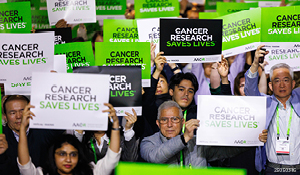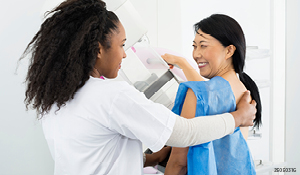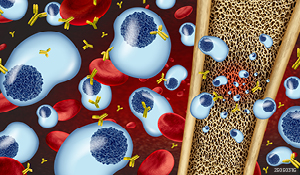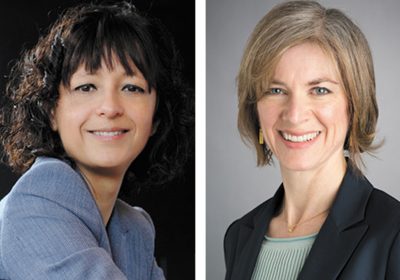Research Updates
Calls Made for Continued Investment in Cancer Research
 With more than 22,100 registrants from 85 countries and territories, the American Association for Cancer Research® (AACR) Annual Meeting 2025 held an Opening Ceremony April 27 that was highlighted by a powerful “Call to Action.” Thousands of attendees held up signs reading “Cancer Research Saves Lives” in support of robust and sustained funding for the National Institutes of Health (NIH).
With more than 22,100 registrants from 85 countries and territories, the American Association for Cancer Research® (AACR) Annual Meeting 2025 held an Opening Ceremony April 27 that was highlighted by a powerful “Call to Action.” Thousands of attendees held up signs reading “Cancer Research Saves Lives” in support of robust and sustained funding for the National Institutes of Health (NIH).

“As the world’s first and largest cancer organization, AACR is globally recognized as the driving force behind scientific advances and practice-changing treatments for cancer,” said Margaret Foti, PhD, MD (hc), CEO of the AACR. “However, while we recognize the incredible strides that are being made in the fight against cancer, we must acknowledge that our work is not finished.”
Cancer mortality has declined by 34% over the past three decades, and there are more than 18 million cancer survivors in the U.S. today, she said, “but recent projections indicate that cancer deaths in the U.S. will increase markedly by the year 2050.”
The AACR is committed to reducing the expected rise in cancer deaths by supporting cancer prevention, early detection, and research into strategies to intercept abnormalities before they become cancer, Dr. Foti said.
“At a time when the scientific community is making enormous strides in these and so many other areas of cancer research, continued investments in biomedical discovery research are critically important,” she said. Yet cuts in federal funding and dramatic reductions in staffing at federal health-related agencies like the NIH and the National Cancer Institute “are threatening to curtail the progress we have made and stymie future advances.”
AACR President Patricia M. LoRusso, DO, PhD (hc), whose term as president ended on April 28, added to the call for federal support for research.
“AACR stands with the entire scientific community and has been fiercely advocating for our members—especially for all of the young investigators for whom this situation is particularly devastating,” she said. “In light of the ongoing upheaval, we are redoubling our efforts to underscore the importance of robust and sustained federal funding to support NIH and its lifesaving mission to accelerate progress for patients with cancer and the hundreds of other diseases that afflict millions of Americans.”
Dr. LoRusso praised the year’s Annual Meeting program for its wide range of topics.
“The AACR Annual Meeting stands strong in its breadth of coverage—showcasing the continuum of innovation for impact across cancer research from paradigm-shifting basic discoveries to high-impact clinical trials, from population sciences to patient advocacy,” she said. “Fundamental insights pave the way for the identification of new therapeutic targets, drug development, clinical testing, and, ultimately, improved patient outcomes.”
During the Opening Ceremony, Dr. Foti announced the new AACR Trailblazer Cancer Research Grants. In total, 15 grants of $1 million each will be given to nine early-stage and six mid-career investigators, the largest single grant program the AACR has ever offered.
Practice-changing Immunotherapy Implications in Head and Neck Cancer
 A new study may change how doctors treat locally advanced head and neck cancer. The phase III KEYNOTE-689 trial found that giving the immunotherapy drug pembrolizumab (Keytruda) both before and after surgery may reduce the chances that the patients’ cancer will come back.
A new study may change how doctors treat locally advanced head and neck cancer. The phase III KEYNOTE-689 trial found that giving the immunotherapy drug pembrolizumab (Keytruda) both before and after surgery may reduce the chances that the patients’ cancer will come back.
The trial enrolled over 700 patients with stage 3 or 4 head and neck squamous cell carcinoma. Everyone had surgery and standard treatment after, but half also got pembrolizumab before and after their operation. Those who received pembrolizumab had fewer cancer recurrences and better overall outcomes—especially patients whose tumors expressed high levels of PD-L1, a marker that helps the immune system recognize threats.
“This new information supports changing the current standard of care to now include neoadjuvant and adjuvant pembrolizumab,” said Ravindra Uppaluri, MD, PhD, the study leader and a surgical oncologist at Brigham and Women’s Hospital, Dana-Farber Cancer Institute, and Harvard Medical School in Boston. “For the first time in more than 20 years, patients with this challenging disease have a new therapeutic approach.”
Based on the trial results, the Food and Drug Administration on June 13 approved pembrolizumab for use in people with resectable locally advanced head and neck squamous cell carcinoma.
A Promising Trend in Early-onset Breast Cancer Survival
 Between 2010 and 2020, breast cancer deaths among U.S. women ages 20 to 49 dropped significantly, even as diagnoses increased, as Adetunji Toriola, MD, PhD, MPH, highlighted during the Annual Meeting while sharing new findings from a SEER registry analysis.
Between 2010 and 2020, breast cancer deaths among U.S. women ages 20 to 49 dropped significantly, even as diagnoses increased, as Adetunji Toriola, MD, PhD, MPH, highlighted during the Annual Meeting while sharing new findings from a SEER registry analysis.
Despite a long-term rise in breast cancer incidence in this age group, incidence-based mortality fell from 9.70 to 1.47 per 100,000 over the decade—an 85% decline in the death rate. The improvement was seen across all major breast cancer subtypes, including triple-negative and HER2-enriched, and across all racial and ethnic groups, with the most notable gains emerging after 2016.
“The improvements in mortality likely reflect advancements in treatment options, greater uptake of precision medicine, and expanded access to care and screening in women aged 40-49,” said Toriola, a molecular cancer epidemiologist and professor of surgery at the Washington University School of Medicine in St. Louis.
He pointed to the broader clinical use of CDK4/6 inhibitors and improved endocrine therapies, both of which became more widely available after 2015, as key drivers behind the progress.
Though the overall survival trends are improving for women of all races, non-Hispanic Black women had the worst survival outcomes. Data suggest that some challenges remain but offer strong evidence that investments in targeted therapies and early detection are saving lives, particularly for women navigating breast cancer in their young adult and middle years.
Charting the Path of Acute Myeloid Leukemia
 Acute myeloid leukemia (AML) is notoriously complex, and patients with the same genetic mutation can have vastly different disease trajectories. At the Annual Meeting, Andy Zeng, PhD, an MD/PhD student at the University of Toronto, presented a powerful new tool to help untangle that complexity: a single-cell RNA sequencing-based atlas of AML cell states.
Acute myeloid leukemia (AML) is notoriously complex, and patients with the same genetic mutation can have vastly different disease trajectories. At the Annual Meeting, Andy Zeng, PhD, an MD/PhD student at the University of Toronto, presented a powerful new tool to help untangle that complexity: a single-cell RNA sequencing-based atlas of AML cell states.
The team—led by senior author John E. Dick, PhD, a senior scientist at the Princess Margaret Cancer Centre in Toronto and a member of the AACR Hematologic Malignancies Working Group Steering Committee—first built a detailed map of normal blood cell development using single-cell RNA sequencing, a long-standing challenge in the field. With this reference in hand, they then analyzed more than 1.2 million AML cells to understand how the disease hijacks normal differentiation. The result: 12 distinct AML cell states that reflect different pathways through which healthy cells are derailed during blood cell development.
Importantly, they found that the same genetic mutation could lead to different disease outcomes depending on the cell’s origin or the presence of other co-occurring mutations. These findings, which were simultaneously published along with an accompanying commentary in the AACR journal Blood Cancer Discovery, explain why AML is so variable across patients and why treatment responses can differ even when the genetics appear similar.
Immunotherapy Can Spare Some Cancer Patients From Surgery
 A groundbreaking cancer treatment approach—using immunotherapy instead of surgery for certain early-stage tumors—received a major update. Andrea Cercek, MD, presented new data from an ongoing phase II trial in which patients with mismatch repair-deficient (dMMR) cancers received PD-1 checkpoint immunotherapy as the first—and potentially only—treatment.
A groundbreaking cancer treatment approach—using immunotherapy instead of surgery for certain early-stage tumors—received a major update. Andrea Cercek, MD, presented new data from an ongoing phase II trial in which patients with mismatch repair-deficient (dMMR) cancers received PD-1 checkpoint immunotherapy as the first—and potentially only—treatment.
This strategy first gained attention in 2022 when remarkable results in patients with rectal cancer were revealed. The latest update, which was simultaneously published in the New England Journal of Medicine, strengthens those and subsequent findings. All rectal cancer patients had a complete clinical response that eliminated the need for surgery, and 65% of patients with other dMMR cancers had similar success.
“These findings are very important for patients with early-stage dMMR tumors because it’s likely they do not need surgery or radiation if they are treated first with immunotherapy for a sufficient amount of time,” said Cercek, a medical oncologist at Memorial Sloan Kettering Cancer Center in New York City.
Liquid biopsy also played a key role. By tracking changes in circulating tumor DNA (ctDNA), the team could monitor patient responses in real time. When ctDNA levels dropped, tumors also disappeared, suggesting that a simple blood test may one day help determine who can safely skip surgery.
HPV Vaccine Breakthrough: One Dose Provides Sufficient Protection
 A major cervical cancer prevention clinical trial may reshape how the world approaches HPV vaccination. At the Annual Meeting, Aimée R. Kreimer, PhD, revealed unblinded results from the landmark ESCUDDO trial, a large government-sponsored study conducted in Costa Rica. The trial followed more than 20,000 girls ages 12 to 16 who received either one or two doses of either the Cervarix or Gardasil 9 vaccine.
A major cervical cancer prevention clinical trial may reshape how the world approaches HPV vaccination. At the Annual Meeting, Aimée R. Kreimer, PhD, revealed unblinded results from the landmark ESCUDDO trial, a large government-sponsored study conducted in Costa Rica. The trial followed more than 20,000 girls ages 12 to 16 who received either one or two doses of either the Cervarix or Gardasil 9 vaccine.
The results were clear and potentially practice-changing: One dose was just as effective as two in preventing persistent infection with HPV types 16 and 18, which cause the vast majority of cervical cancers. In both groups, vaccine efficacy exceeded 97%.
“A lot of countries with very large birth cohorts of girls still have yet to introduce HPV vaccination,” said Kreimer, a senior investigator at the National Cancer Institute. “A global single-dose HPV recommendation should facilitate country introductions and vaccine uptake.”
The implications are global. Single-dose vaccination could dramatically simplify logistics, reduce costs, and increase access in low- and middle-income countries, where the burden of cervical cancer is highest and where multi-dose programs can be difficult to implement. With this new evidence, the road to eliminating cervical cancer may have just become a lot more navigable.
To support cancer researchers worldwide at all career levels, please consider making a gift to the AACR.





